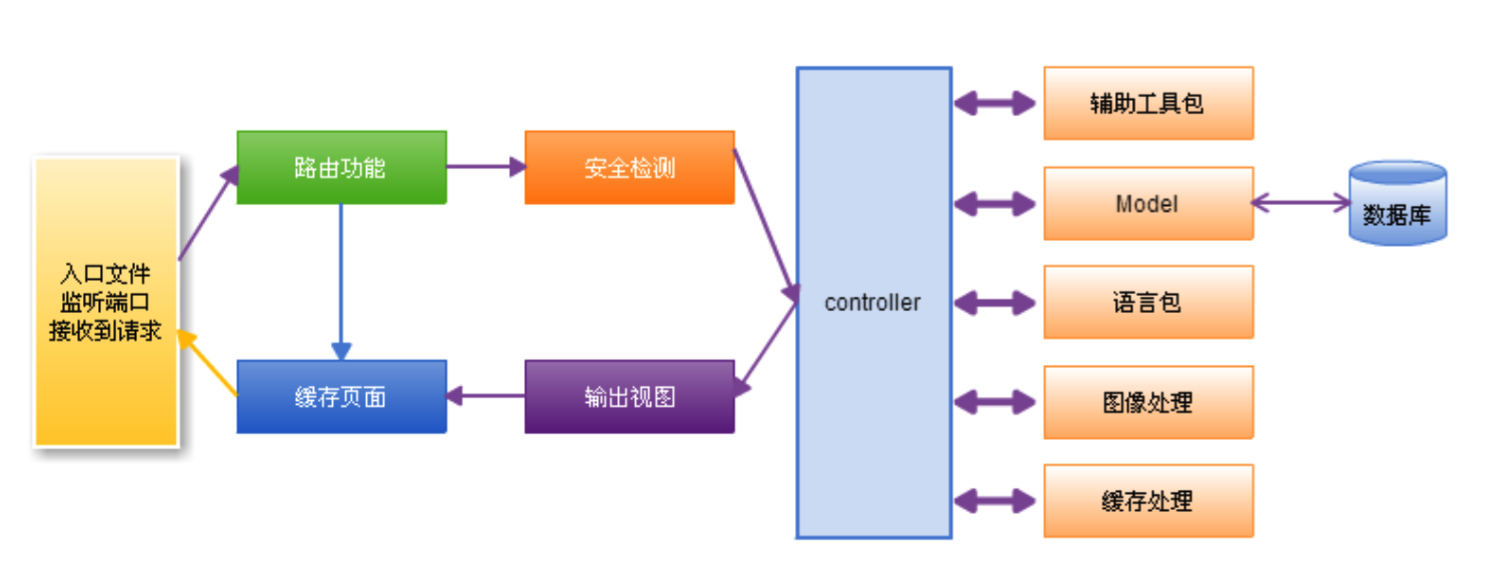Go Web 设计一个Web框架
项目规划
gopath以及项目设置
首先需要设置好gopath路径,gopath 可以设置多个目录export gopath=/home/xxxx/gopath
必须保证gopath这个代码目录下面有三个目录pkg、bin、src
项目的源码放置在src目录下
应用流程图
采用MVC架构
- main.go 作为应用入口,初始化一些运行博客所需要的基本资源,配置信息,监听端口。
- 路由功能检查HTTP请求,根据URL以及method来确定谁(控制层)来处理请求的转发资源。
- 如果缓存文件存在,它将绕过通常的流程执行,被直接发送给浏览器。
- 安全检测:应用程序控制器调用之前,HTTP请求和任一用户提交的数据将被过滤。
- 控制器装载模型、核心库、辅助函数,以及任何处理特定请求所需的其它资源,控制器主要负责处理业务逻 辑。
- 输出视图层中渲染好的即将发送到Web浏览器中的内容。如果开启缓存,视图首先被缓存,将用于以后的常规 请求。
目录结构
|——main.go 入口文件
|——conf 配置文件和处理模块
|——controllers 控制器入口
|——models 数据库处理模块
|——utils 辅助函数库
|——static 静态文件目录
|——views 视图库
框架设计
框架包括路由功能、支持REST的控 制器、自动化的模板渲染,日志系统、配置管理等。
具体实现
自定义路由设计
HTTP路由组件负责将HTTP请求交到对应的函数处理
- 默认的路由实现
func fooHandler(w http.ResponseWriter, r *http.Request) {
fmt.Fprintf(w, "Hello, %q", html.EscapeString(r.URL.Path))
}
http.HandleFunc("/foo", fooHandler)
http.HandleFunc("/bar", func(w http.ResponseWriter, r *http.Request) {
fmt.Fprintf(w, "Hello, %q", html.EscapeString(r.URL.Path))
})
log.Fatal(http.ListenAndServe(":8080", nil))
路由实现思路:
- 添加路由信息
- 根据用户请求转发到要执行的函数
Go默认的路由添加是通过函数 http.Handle 和 http.HandleFunc 等来添加,底层都是调用了DefaultServeMux.Handle(pattern string, handler Handler) ,这个函数会把路由信息存储在一个map信息中 map[string] muxEntry ,这就
解决了上面说的第一点。
Go监听端口,然后接收到tcp连接会扔给Handler来处理,上面的例子默认nil即为 ,通过 D 函数来进行调度,遍历之前存储的map路由信息,和用户访问的URL进行匹配,以查询对 应注册的处理函数,这样就实现了上面所说的第二点。
路由实现:
Go自带的缺陷:
- 不支持参数设定,例如/user/:uid 这种泛类型匹配
- 无法很好的支持REST模式,无法限制访问的方法,例如上面的例子中,用户访问/foo,可以用GET、POST、DE LETE、HEAD等方式访问
- 一般网站的路由规则太多了,编写繁琐。我前面自己开发了一个API应用,路由规则有三十几条,这种路由多 了之后其实可以进一步简化,通过struct的方法进行一种简化
路由分类
存储路由
根据以上路由的缺陷, 需要解决参数支持就需要用到正则, REST的方法对应到struct的方法中去,然后路由到struct而不是函数,这样在转发路由的时候就可以根据met hod来执行不同的方法。
根据上面的思路,我们设计了两个数据类型controllerInfo(保存路径和对应的struct,这里是一个reflect.Type 类型)和ControllerRegistor(routers是一个slice用来保存用户添加的路由信息,以及beego框架的应用信息)type controllerInfo struct { regex *regexp.Regexp params map[int]string controllerType reflect.Type } type ControllerRegistor struct { routers []*controllerInfo Application *App }其中
ControllerRegistor对外的接口是如下形式
func (p *ControllerRegistor) Add(pattern string, c ControllerInterface)func (p *ControllerRegistor) Add(pattern string, c ControllerInterface) { parts := strings.Split(pattern, "/") j := 0 params := make(map[int]string) for i, part := range parts { if strings.HasPrefix(part, ":") { expr := "([^/]+)" //a user may choose to override the defult expression // similar to expressjs: ‘/user/:id([0-9]+)’ if index := strings.Index(part, "("); index != -1 { expr = part[index:] part = part[:index] } params[j] = part parts[i] = expr j++ } } //recreate the url pattern, with parameters replaced //by regular expressions. then compile the regex pattern = strings.Join(parts, "/") regex, regexErr := regexp.Compile(pattern) if regexErr != nil { //TODO add error handling here to avoid panic panic(regexErr) return } //now create the Route t := reflect.Indirect(reflect.ValueOf(c)).Type() route := &controllerInfo{} route.regex = regex route.params = params route.controllerType = t p.routers = append(p.routers, route) }静态路由实现
Go的http包默认支持静态文件处理FileServer,由于我们实现了自定义的路由 器,那么静态文件也需要自己设定,beego的静态文件夹路径保存在全局变量StaticDir中,StaticDir是一个map 类型func (app *App) SetStaticPath(url string, path string) *App { StaticDir[url] = path return app } beego.SetStaticPath("/img","/static/img")
转发路由
转发路由是基于ControllerRegistor里的路由信息来进行转发的// AutoRoute func (p *ControllerRegistor) ServeHTTP(w http.ResponseWriter, r *http.Request) { defer func() { if err := recover(); err != nil { if !RecoverPanic { // go back to panic panic(err) } else { Critical("Handler crashed with error", err) for i := 1; ; i += 1 { _, file, line, ok := runtime.Caller(i) if !ok { break } Critical(file, line) } } } }() var started bool for prefix, staticDir := range StaticDir { if strings.HasPrefix(r.URL.Path, prefix) { file := staticDir + r.URL.Path[len(prefix):] http.ServeFile(w, r, file) started = true return } } requestPath := r.URL.Path //find a matching Route for _, route := range p.routers { //check if Route pattern matches url if !route.regex.MatchString(requestPath) { continue } //get submatches (params) matches := route.regex.FindStringSubmatch(requestPath) //double check that the Route matches the URL pattern. if len(matches[0]) != len(requestPath) { continue } params := make(map[string]string) if len(route.params) > 0 { //add url parameters to the query param map values := r.URL.Query() for i, match := range matches[1:] { values.Add(route.params[i], match) params[route.params[i]] = match } //reassemble query params and add to RawQuery r.URL.RawQuery = url.Values(values).Encode() + "&" + r.URL.RawQuery //r.URL.RawQuery = url.Values(values).Encode() } //Invoke the request handler vc := reflect.New(route.controllerType) init := vc.MethodByName("Init") in := make([]reflect.Value, 2) ct := &Context{ResponseWriter: w, Request: r, Params: params} in[0] = reflect.ValueOf(ct) in[1] = reflect.ValueOf(route.controllerType.Name()) init.Call(in) in = make([]reflect.Value, 0) method := vc.MethodByName("Prepare") method.Call(in) if r.Method == "GET" { method = vc.MethodByName("Get") method.Call(in) } else if r.Method == "POST" { method = vc.MethodByName("Post") method.Call(in) } else if r.Method == "HEAD" { method = vc.MethodByName("Head") method.Call(in) } else if r.Method == "DELETE" { method = vc.MethodByName("Delete") method.Call(in) } else if r.Method == "PUT" { method = vc.MethodByName("Put") method.Call(in) } else if r.Method == "PATCH" { method = vc.MethodByName("Patch") method.Call(in) } else if r.Method == "OPTIONS" { method = vc.MethodByName("Options") method.Call(in) } if AutoRender { method = vc.MethodByName("Render") method.Call(in) } method = vc.MethodByName("Finish") method.Call(in) started = true break } //if no matches to url, throw a not found exception if started == false { http.NotFound(w, r) } }
使用入门
- 基本使用注册路由
beego.BeeApp.RegisterController("/", &controllers.MainController{}) - 参数注册
beego.BeeApp.RegisterController("/:param", &controllers.UserController{}) - 正则匹配
beego.BeeApp.RegisterController("/users/:uid([0-9]+)", &controllers.UserController{})